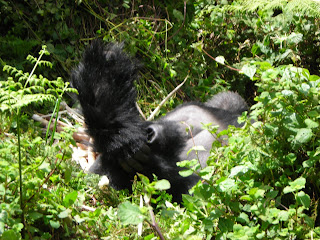

This has been a week full of animal adventures! Three days after visiting Akagera Game Reserve, I traveled with Theo and Burch via public bus to Musanze (formerly Ruhengeri) in the northeast corner of Rwanda. A few weeks prior we purchased permits from the Rwandan Tourism Office to hike Volcanoes National Park and spend an hour in the company of a troupe of silverback mountain gorillas. These endangered animals live in groups of 10-20 and are among the only remaining of their kind throughout the world, scattered in this mountainous area composed of seven inactive volcanoes, where Uganda, Rwanda and DRC converge. The region is stunning in its beauty, dense in bamboo and rainforest, and visiting makes you understand a little better why anthropologist Dian Fossey chose to spend decades of her life here.
In recent years, Rwanda has used its proximity to the mountain gorillas to its advantage while respecting the species’ environment and way of life. A limited number of permits are issued each day for residents and visitors to embark on guided hikes into the mountains near Musanze in search of the silverbacks. I went with a group of eight into the thickets of Sabinyo (3634m), where we encountered 12 gorillas – one dominant male silverback, several females, younger adolescent males and three babies. Once you arrive at the gorilla troupe’s site (it changes day-to-day within a range of the forest – we hiked uphill for about 3 hours prior to our encounter), you are allowed to spend an hour with them observing their activities: eating, grooming, playing, resting, peeling back bamboo shoots and more. Videos and photos are permitted, but you are advised to keep a distance of about 3 meters and avoid prolonged eye-contact, particularly with the male silverback.
Hiking in Volcanoes National Park and spending time with mountain gorillas was an unforgettable experience. There is such a human quality to their demeanor, and while they don’t seem bothered by our presence in their natural habitat, they do express intrigue. Check out the photos and videos to get a sense of this.







